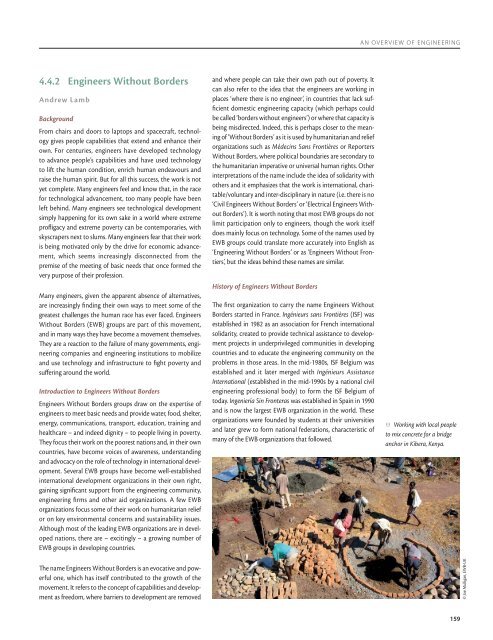Engineering: issues, challenges and opportunities for development ...
Engineering: issues, challenges and opportunities for development ...
Engineering: issues, challenges and opportunities for development ...
Create successful ePaper yourself
Turn your PDF publications into a flip-book with our unique Google optimized e-Paper software.
AN OVERVIEW OF ENGINEERING4.4.2 Engineers Without BordersAndrew LambBackgroundFrom chairs <strong>and</strong> doors to laptops <strong>and</strong> spacecraft, technologygives people capabilities that extend <strong>and</strong> enhance theirown. For centuries, engineers have developed technologyto advance people’s capabilities <strong>and</strong> have used technologyto lift the human condition, enrich human endeavours <strong>and</strong>raise the human spirit. But <strong>for</strong> all this success, the work is notyet complete. Many engineers feel <strong>and</strong> know that, in the race<strong>for</strong> technological advancement, too many people have beenleft behind. Many engineers see technological <strong>development</strong>simply happening <strong>for</strong> its own sake in a world where extremeprofligacy <strong>and</strong> extreme poverty can be contemporaries, withskyscrapers next to slums. Many engineers fear that their workis being motivated only by the drive <strong>for</strong> economic advancement,which seems increasingly disconnected from thepremise of the meeting of basic needs that once <strong>for</strong>med thevery purpose of their profession.Many engineers, given the apparent absence of alternatives,are increasingly finding their own ways to meet some of thegreatest <strong>challenges</strong> the human race has ever faced. EngineersWithout Borders (EWB) groups are part of this movement,<strong>and</strong> in many ways they have become a movement themselves.They are a reaction to the failure of many governments, engineeringcompanies <strong>and</strong> engineering institutions to mobilize<strong>and</strong> use technology <strong>and</strong> infrastructure to fight poverty <strong>and</strong>suffering around the world.Introduction to Engineers Without BordersEngineers Without Borders groups draw on the expertise ofengineers to meet basic needs <strong>and</strong> provide water, food, shelter,energy, communications, transport, education, training <strong>and</strong>healthcare – <strong>and</strong> indeed dignity – to people living in poverty.They focus their work on the poorest nations <strong>and</strong>, in their owncountries, have become voices of awareness, underst<strong>and</strong>ing<strong>and</strong> advocacy on the role of technology in international <strong>development</strong>.Several EWB groups have become well-establishedinternational <strong>development</strong> organizations in their own right,gaining significant support from the engineering community,engineering firms <strong>and</strong> other aid organizations. A few EWBorganizations focus some of their work on humanitarian relie<strong>for</strong> on key environmental concerns <strong>and</strong> sustainability <strong>issues</strong>.Although most of the leading EWB organizations are in developednations, there are – excitingly – a growing number ofEWB groups in developing countries.<strong>and</strong> where people can take their own path out of poverty. Itcan also refer to the idea that the engineers are working inplaces ‘where there is no engineer’, in countries that lack sufficientdomestic engineering capacity (which perhaps couldbe called ‘borders without engineers’) or where that capacity isbeing misdirected. Indeed, this is perhaps closer to the meaningof ‘Without Borders’ as it is used by humanitarian <strong>and</strong> relie<strong>for</strong>ganizations such as Médecins Sans Frontières or ReportersWithout Borders, where political boundaries are secondary tothe humanitarian imperative or universal human rights. Otherinterpretations of the name include the idea of solidarity withothers <strong>and</strong> it emphasizes that the work is international, charitable/voluntary<strong>and</strong> inter-disciplinary in nature (i.e. there is no‘Civil Engineers Without Borders’ or ‘Electrical Engineers WithoutBorders’). It is worth noting that most EWB groups do notlimit participation only to engineers, though the work itselfdoes mainly focus on technology. Some of the names used byEWB groups could translate more accurately into English as‘<strong>Engineering</strong> Without Borders’ or as ‘Engineers Without Frontiers’,but the ideas behind these names are similar.History of Engineers Without BordersThe first organization to carry the name Engineers WithoutBorders started in France. Ingénieurs sans Frontières (ISF) wasestablished in 1982 as an association <strong>for</strong> French internationalsolidarity, created to provide technical assistance to <strong>development</strong>projects in underprivileged communities in developingcountries <strong>and</strong> to educate the engineering community on theproblems in those areas. In the mid-1980s, ISF Belgium wasestablished <strong>and</strong> it later merged with Ingénieurs AssistanceInternational (established in the mid-1990s by a national civilengineering professional body) to <strong>for</strong>m the ISF Belgium oftoday. Ingeniería Sin Fronteras was established in Spain in 1990<strong>and</strong> is now the largest EWB organization in the world. Theseorganizations were founded by students at their universities<strong>and</strong> later grew to <strong>for</strong>m national federations, characteristic ofmany of the EWB organizations that followed. Working with local peopleto mix concrete <strong>for</strong> a bridgeanchor in Kibera, Kenya.The name Engineers Without Borders is an evocative <strong>and</strong> powerfulone, which has itself contributed to the growth of themovement. It refers to the concept of capabilities <strong>and</strong> <strong>development</strong>as freedom, where barriers to <strong>development</strong> are removed© Joe Mulligan, EWB-UK159

















